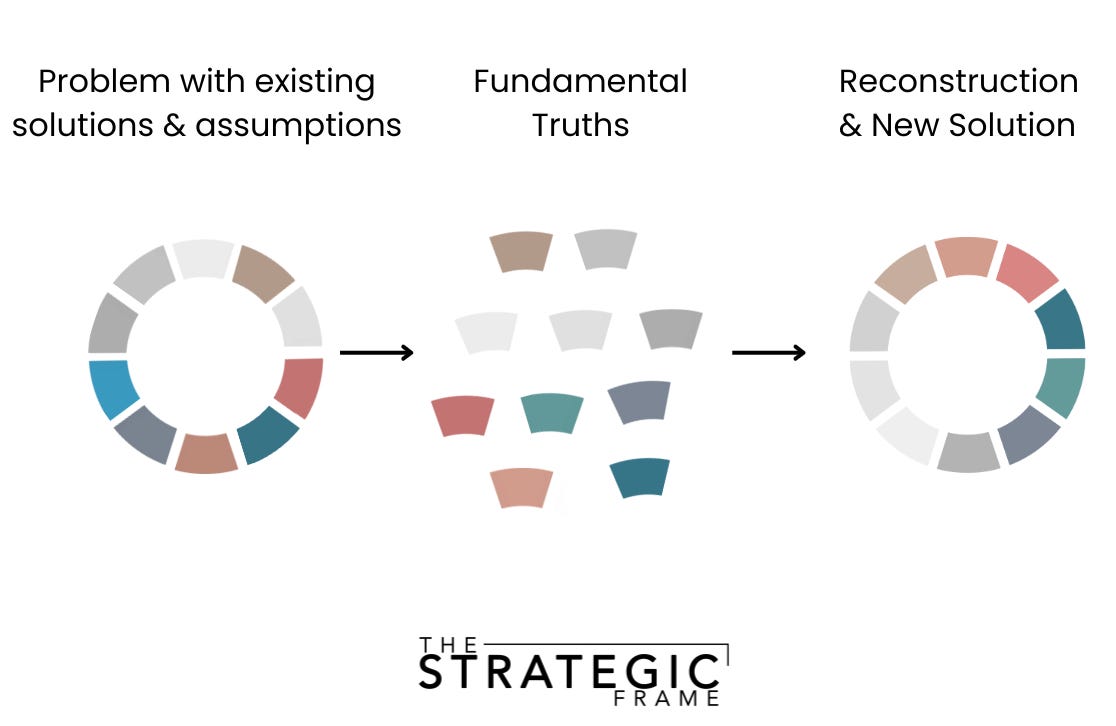First Principles
Solve problems by breaking them into core truths
EXECUTIVE SUMMARY:
First Principles Thinking is a method of solving problems by breaking them down to their core truths, then rebuilding from the ground up. It helps you move beyond assumptions and conventional wisdom to find truly original solutions. Companies like Dyson and Liquid Death used it to redefine their categories by rethinking from scratch rather than tweaking what already existed.
If you’re not from the Bay Area, you may not hear the term “First Principles” commonly. That’s absolutely true for me. Nobody says it in my circles in Utah, but when I visit friends and clients in California, it will undoubtedly be referenced more than once.
What is First Principles Thinking?
First Principles Thinking is a method where you boil problems down to the most fundamental truths, and then reason up from there.
It’s not unlike the MECE process outlined in last week’s Strategic Frame, linked here in case you missed it. It’s almost MECE, backwards. Instead of taking a problem and exploring options on how you can solve it, you take a problem and break down what was true about that problem to begin with. It challenges assumptions.
The concept of First Principles was popularized by Elon Musk over a decade ago, when Tesla and SpaceX were rapidly innovating technologies and applications of technologies for electric vehicles and space exploration. You can view a clip of his explanation, along with his frequently referenced battery example here.
Steps To Apply First Principles Thinking
Here’s how to apply First Principles Thinking:
Identify a problem clearly
Define the problem in simple, unambiguous terms without jumping to solutions.
Challenge all assumptions
Question everything you think you know about the problem, including industry norms.
Break the problem down to its fundamental truths
Strip the problem to the facts that are objectively true and undeniable.
Reconstruct a solution from the ground up
Build a new approach using only those core truths, not existing models.
Refine the solution
Test, iterate, and improve based on real-world feedback.
Dyson and Liquid Death
First Principles can be applied to both product innovations, where the products and technologies themselves are improved, as well as user innovations, where new markets are created based on how something is framed.
Dyson serves as a great product innovation example:
Identify a problem clearly
Vacuums require annoying bag changes and lose suction over time.
Challenge all assumptions
Vacuum cleaners need bags.
Vacuum cleaners will lose suction over time.
Break the problem down to its fundamental truths
What is the goal of a vacuum? Effective suction and continuous airflow.
Why do conventional vacuums lose suction? Dust clogs filters and bags, breaking the airflow.
Reconstruct a solution from the ground up
Can we eliminate the clogging mechanism entirely?
Cyclonic separators used in sawmills and factories already exist, which remove particulates from airstreams without the use of filters.
We can shrink the cyclonic separator technology and apply it to a household vacuum cleaner.
We can build a premium brand around advanced engineering, visible dirt collection, and reliability.
Refine the solution
After 5,000 product iterations, Dyson led a category shift where bagless vacuums became the standard, which allowed Dyson to command premium pricing and dominate the market.
Liquid Death serves as a great user innovation example:
Identify a problem clearly
Can we build a new business selling water?
Challenge all assumptions
Drinking water is a commodity.
Plastic bottles are the only way to sell drinking water.
To win in the market, compete on purity, sustainability, or price.
Break the problem down to its fundamental truths
What is bottled water at its core? Simply H2O in a container, sometimes with added or natural minerals.
Why do consumers really buy bottled water? In addition to hydration, they buy for convenience and identity-signaling.
Reconstruct a solution from the ground up
What if water was branded more like a lifestyle product than a health product?
What if we put water in tallboy aluminum cans styled like beer or energy drinks?
Can we create a new market through edgy branding with skulls, dark humor, and slogans such as “Murder Your Thirst,” which purposefully break from typical wellness packaging?
Refine the solution
After various market tests through commercials that validated the demand, Liquid Death launched their canned water brand with edgy marketing and saw rapid growth and loyalty among Gen Z, reaching a $1.4B valuation in 2024, despite selling essentially the same commodity as other, established beverage companies.
Wrapping It All Up
Is there a way you can apply First Principles Thinking at your company? What problems are you trying to solve? What assumptions do you hold, which may not ultimately be true?
This email is sponsored by Krosswood Doors
Krosswood Doors is a leading provider of premium interior and exterior doors that seamlessly blend aesthetics, quality, and durability. Shop now at https://www.krosswood.com/.
Sources & Further Reading:



